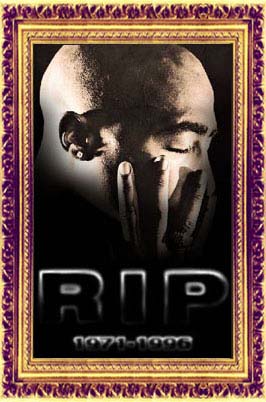
After murders of top stars, genre gives way to party jams
by J.D. Considine of the Baltimore Sun
In the wee hours of March 9, 1997, Christopher Wallace - a man known by millions of
rap fans as Biggie Smalls or Notorious B.I.G.- was shot to death while sitting in a black
Chevy Suburban outside the Petersen Automotive Museum in Los Angeles.
Coming barely six months after the similarly violent demise of fellow rap
SUPER star Tupac Shakur, Biggie’s death left the rap world reeling. There was an
immediate outpouring of grief- and a flood of rumours as well. Many wondered if the
two deaths weren’t an outgrowth of the much hyped gangsta rap “war” between the West
Coast crew of DeathRow Records and the East Coast Posse of BadBoy Records (whose
numbers included Biggie Smalls).
A Year Later, both murders remain unsolved, with no indictments pending. Bad
Boy’s chief, Sean “Puffy” Combs, shifted gears to a more pop-oriented sound and had a
banner year., dominating the charts through his own singles and those produced by
Biggie. Meanwhile, Marion “Suge” Knight, the head of Death Row Records, is serving a
nine-year prison term for assault after having had his probation revoked in February
1997.
But another casualty in these shootings may have been gangsta rap itself.
Although posthumous albums by both Biggie and Tupac sold well, they were the
exception among gangsta acts. Where once the charts were clogged with gun-totin’,
hard-cussin’ hits by the likes of Dr. Dre, Snoop, Ice Cube, Ice-T, and the Geto Boys, the
biggest rap singles of the last year have been perky, party oriented jams by such artists as
Will Smith. Lil’ Kim, Heavy D, Freak Nasty, and the ubiquitous Puffy Combs.
Gangsta Albums are still being released, of course- they’re just not doing the
business they used to. Last week, for instance, saw the release of the soundtrack “Caught
Up” that includes contributions by Snoop Doggy Dogg, Kurupt, Mack 10, and the Luniz.
Three years ago, a line up like that would have guaranteed the album would enter the
charts in the top five; instead , it came in at No. 30.
Most of the genre’s big stars are barely active. Dr. Dre hasn’t released anything
since “Dr. Dre presents the Aftermath” was released in late 1996 (although he is said to
be completing an album with Snoop). Ice-T’s more often found in movies or on TV than
on the rap charts; his last album was with the thrash metal band Body Count. And after
releasing a reunion album in the spring of 96, the Geto Boys once again went their
separate ways.
Still it’s hard to say just how much of a real shift in sensibilities this trend represents.
Many in hip-hop will argue that the whole “gangsta rap” movement was all hype anyway.
First, “you have to accept the notion that there was such a thing as gangsta rap,:
said Bill Stephney, president of Step Sun Entertainment. A musician and producer who
got his start working with the likes of Public Enemy, Stephney declines to acknowledge
that there was even such a thing as gangsta.
“But for the more violence-oriented music that did reflect either gang life or
drug-trade, it seems to be that that’s on the wane,” he said. “And it has been on the wane
preceding the deaths of Tupac Shakur and Big.”
In part, that may be because rap music, like everything else in pop culture, runs in
cycles. To that extent, the gangsta boom may be like the slasher-flick craze of the 80’s.
Like gangsta recordings, slasher flicks were considered sexist and gory, were accused of
desensitizing teenagers to violence and were denounced by parent’s groups across the
country. But as the novelty wore off, the boom went bust just as gangsta rap seems to be
doing.
There are many in the rap world who don’t believe there was an actual “war”
betweent he West and East. Hip-hop journalist Ronin Ro, the author of the book “Have
Gun, Will Travel: The Spectacular Rise and Violent Fall of Death Row Records” argues
that the only real conflict was bad blood between Death Row’s Knight and Bad Boy’s
Buffy.

“It was a feud” he said. “It got hyped up into a big, bicoastal civil war by irresponsible
magazines and journalists, like people at The New York Times and Newsweek. But it
was just a corporate feud, man. Suge did not like Puffy and Puffy kept rubbing his
success at Suge’s face.”
Still, the big question for rap fans has less to do with whether Suge Knight will
take revenge on Puffy Combs than with that sort of music will rise up in gangsta’s wake.
“I think this is a time of great possibility but also a time of great boredom,”
Stephney said, “My own interest in hip-hop is that it remain as an outside voice, yelling
at the institutions and canons of society and it doesn’t seem to be doing that. It seems to
be accepting those institutions for purposes of promoting a very materialistic lifestyle.
“I think we need a younger Chuck D now,” he said, referring to Public Enemy’s front
man. “But a Chuck D who would mirror what it would be like to be a 21 year old with
the millenium coming.”
Ro champions the innovation and social commentary of Gangstarr; A Tribe Called Quest
and Jeru the Damaja. More than anything, though, he hopes the deaths of Tupac and
Biggie will remind rappers that they have a responsibility to their audiences.
“Most rappers don’t say anything worth hearing,” he said. “They’re just selfish and very
greedy.
“They talk about drug deals and guns, all this criminal stuff, and gross materialism.
They’re not even thinking that standing near them, maybe even right up to their knees, is
a young child.
“Maybe they should try to use their time in the media to say something that could
possibly offer some hope or guidance.”

LE FastCounter




